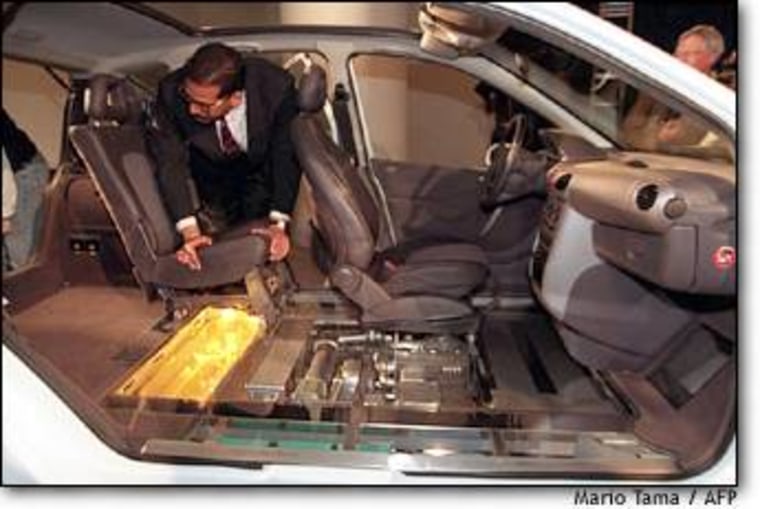A revolution is in the works. Here in western Canada and also in remote Iceland; in Stuttgart, Detroit and Tokyo, too, the plot is thickening. The target: the internal combustion engine, the ancient regime of the industrial world. The plot being hatched would change the way the world’s cars and homes are run. And, if you believe that carbon emissions may be warming the planet and playing havoc with its climate, then this is a revolution that may just save the Earth.
After years of naysaying, and spurred by new science on the climate issue, some carmakers, oil giants and power companies have joined governments and environmentalists in the push to develop cleaner power sources.
As with all revolutions, however, what happens between now and its execution will be messy. Battles will be fought over interim technologies. Big money interests will try to strangle innovations that threaten their franchises. Government policies will grapple, with variable success, with the issues raised by the new technologies.
David Nemtzow, head of the bipartisan, public-private Alliance to Save Energy, says his worst fear is what might happen during those battles.
“Will we make the right decisions? Will we have the right incentives?” he asks. “We still don’t know and there’s plenty of reason to be nervous.”
Neither solar, nor nuclear
The revolution would overthrow three icons of the industrial age: the internal combustion engine, petroleum and power plants fired by coal - all sources of carbon emissions, which many scientists fear are compounding the natural “greenhouse” effect that traps heat in Earth’s atmosphere.

In effect, the generators of power for our cars and our homes, our offices and our stores, would be supplanted by something cleaner.
But what’s capable of all that? A few years ago, some hoped that solar energy or perhaps even nuclear power would fill the void. But the limitations of solar energy and the risks of the atom dampened enthusiasm for those solutions.
In the past few years, however, a new alternative has risen based on the most abundant element on Earth: hydrogen.
“Fuel cells” offer a technology that can tap hydrogen’s carbon-free energy, and have already supplanted solar and nuclear alternatives as a growth research area.
The basic fuel cell mixes hydrogen and oxygen, creating a chemical reaction that produces electricity. That in turn powers a motor.
Not surprisingly, support for hydrogen and fuel cells is broad-based. Praise from government, industry and environmentalists includes terms like “staggering” and “revolutionize” and “the beginning of the hydrogen age.”
Heading to hydrogen
Fuel cells could be used not only in vehicles but also in our homes, offices, industries and even our cell phones and laptops. That’s significant because U.S. greenhouse gas emissions are divided about evenly among vehicles, buildings and industry.
In some ways, hydrogen is a natural step in humankind’s energy evolution. Earth’s first societies were fueled by wood, then coal and today petroleum as well as natural gas. With each step there’s more hydrogen and less carbon in the energy cycle.
The triad of modern industry - internal combustion engines, petroleum and power plants - rely heavily on another carbon, another basic element.
Like hydrogen, carbon is in us and all around us. But when used to create energy it emits smog-producing gases as well as carbon dioxide, the single most important “greenhouse” gas.
At present, carbon emissions are about 6.5 billion metric tons each year worldwide — that works out to 22 billion tons of CO2, which is created when carbon is burned. Some scientists have long believed that to be an unsustainable situation. Now, with climate worries on the rise, many scientists believe these emissions are doing damage to the planet.
Fueling the car culture
The idea behind fuel cells has been around since 1839, but the first significant use was by NASA to power the Gemini and Apollo spaceships - a tradition that continues with today’s shuttles.
Cost and size were huge obstacles until a few years ago, when advances by government and industry researchers brought both down significantly.
Ballard Power Systems here in suburban Vancouver is one of the leaders. The company has $750 million in financial support from Ford and DaimlerChrysler, which hope to mass produce fuel cell cars in the next few years that match the performance of today’s cars.
A major step was taken earlier this year when DaimlerChrysler unveiled a subcompact fuel-cell car. Ferdinand Panik, DaimlerChrysler’s head of fuel-cell research, described the breakthrough as “comparable to the impact the microchip had on computer technology when it replaced the transistor.”
A key issue is what kind of fuel to use to get the cycle going. The chemical process needs to be activated, and the cleanest way - in effect, no carbon emissions - would be using pure hydrogen or even solar energy.
But a solar solution is long-term and getting gas stations to sell hydrogen and finding safe ways to move it around is a challenge. Revolutionaries feel it will happen, but not right away and that in the meantime a more acceptable fuel must be used. Regular unleaded is a possibility, as are methanol, ethanol, natural gas and other fuels.
Those all contain carbon, but fuel cells would still be cleaner than the internal combustion engine because they get two to three times as much energy, and thus mileage, out of each gallon.
Home is where the hydrogen is?
Fuel cell companies are also developing “stationary” generators to power homes, offices, hospitals and stores. The first uses have been in isolated areas or where a reliable power supply is crucial - casinos and banks, among them. Hospitals are another logical market. But the technology is spreading:
The First National Bank of Omaha, the largest independent U.S. bank, last month bought a fuel cell power system for its computer center, citing concerns about a centralized power grid susceptible to outages. The fuel cell not only powers the computers, but also heats the building and water - and even melts the snow on the outdoor walkways. Run on natural gas, it also cuts CO2 emissions by nearly half compared with a diesel power generator.
The biggest player to jump into the market is General Electric, which recently joined with Plug Power to promise fuel-cell generators for the home and office in 2001. Costs will be $7,500 to $10,000 initially — but are expected to drop to $3,500 once mass produced. That would come out to 7-10 cents per kilowatt-hour. (General Electric also owns NBC, a partner in the joint venture that owns MSNBC.)
In Oregon, the Bonneville Power Administration is buying 110 fuel-cell generators to test them in homes following a successful two-year pilot project.
Longer term, if the costs come down to or below what we pay for electricity now - it’s possible the centralized power grid would simply be obsolete for many uses, replaced by fuel cells in garages or basements to light, heat and cool our homes.
Playing it cool in Iceland
Ironically, Iceland, where you’d think they might like a warmer Earth, plans to become the world’s first hydrogen-based economy and pass along its lessons to other countries.
The island nation is already the world leader in renewable energy — 67 percent of the economy runs on geothermal or other renewable power.
But the government, backed by Shell and DaimlerChrysler, wants to further that leadership, replacing the internal combustion engines on its entire transportation and fishing fleets with fuel cells.
“Within ten to fifteen years,” predicts Hjalmar Arnason, an Icelandic lawmaker and chairman of its Committee for Alternative Fuel, “we will see radical changes in our society with respect to hydrogen and fuel cells.”
U.S. arena
In the United States, Democrats and climate activists tend to prefer a carrot and stick approach to getting industry to reduce carbon emissions.
Republicans and industry tend to feel it’s all well and good to develop technologies to reduce emissions but that mandating cuts, as many governments agreed to do in the 1997 Kyoto climate change accord, will retard economic growth.
Staking out the center of the debate are groups like the Alliance and the Pew Center on Climate Change, whose 21 corporate partners believe enough is known about global warming to warrant preventive action now.
“The ‘ultimate’ solutions probably are 50 years out in the future,” says Pew director Eileen Claussen, “but that doesn’t mean we can’t take steps” in the meantime.
“Neither technology nor policy can do the job on their own,” she adds. “What you need is the right mix.”
The Pew Center doesn’t claim to know what that mix is, though it hopes its own presence as a business voice of climate concern will build consensus. Says Claussen: “We want to prevent this from being a terminal planet.”
